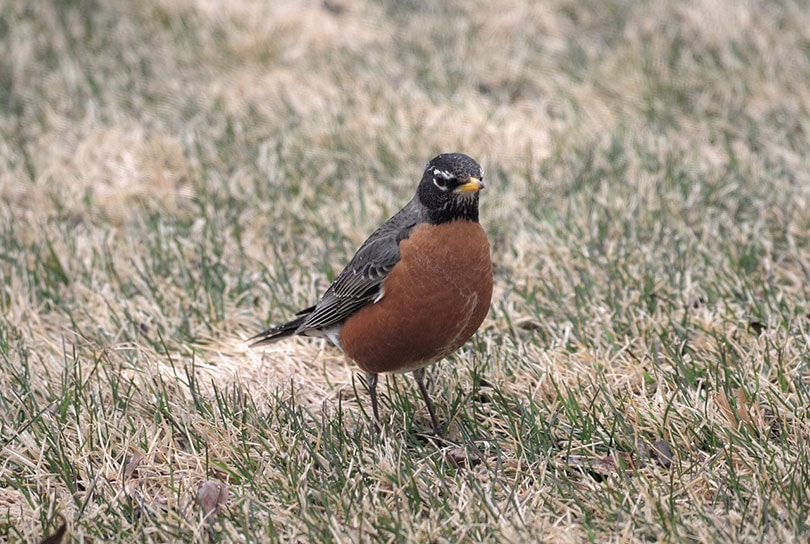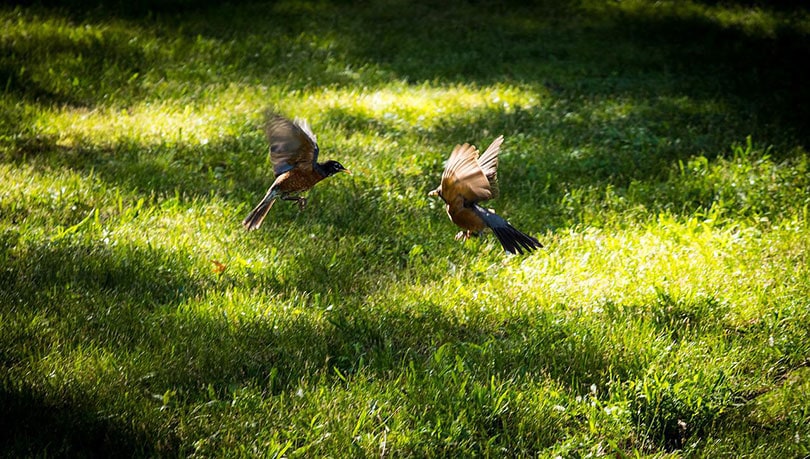10 Interesting Facts About the American Robin You Never Knew
Last Updated on

Have you ever wondered what makes the American Robin such a popular bird? Does it seem like you see one of these birds in every crack and crevice of any town in the country? If so, don’t click away because this article will go over some of the coolest things about this species and what makes it a special place in our hearts. You might learn something you never knew about this familiar face, so here are 11 interesting facts about the American Robin!

The 10 Interesting Facts About the American Robin You Never Knew
1. There Are Around 370 Million American Robins
As one of the most frequently seen birds in North America, it’s no surprise that the total population of this species gets into the hundreds of millions. In fact, the number could far exceed the 370 million estimate, and the American robin is considered to be the most common bird living on the continent. They live in Canada, Mexico, and the United States respectively, and it’s unlikely you won’t find one roaming the streets or scattered across the backcountry.

2. It Represents Three States
With such strong familiarity and prominence, it was only natural that three American states chose the robin as their official state bird. A couple of midwestern states, Michigan and Wisconsin, both hold the species as its state bird.
The small northeastern state of Connecticut also has the robin as its state bird. Not many birds are representative of multiple states, as many choose a species unique to only their region. The robin makes it easy since they can be found plentifully in almost any place in the US.
3. The Oldest American Robin Lived Almost 14 Years
Although it’s just a fraction of the average human lifetime, one record proves that a robin survived until nearly the age of 14, becoming the oldest ever known to man. That is quite a far cry from the average lifespan of this species, which is only a couple of years. In fact, most robins don’t make it out of their early years, and studies have shown that just 25% of them reach a year old while undomesticated. Despite this hardship, one toughed it out for over a decade.
4. They Can Have Offspring Several Times a Year
A few sources note that robins often breed up to three times in their mating period, laying from 3–5 eggs per brood in their nests. These eggs can be hatched in just 2 weeks. Additionally, female robins will create nests that are hidden behind dense bushes, branches, or trees so they can stay protected. However, there are times when they may choose to build their homes in domestic areas, such as porches, man-made lights, or other household objects.

5. Robin Eggs Are Blue
Contrary to their orange bellies, blackish-gray wings, and yellow beaks, a female American Robin can lay eggs that display a vibrant turquoise blue color. The reason why this occurs is due to a pigmentation known as biliverdin, which saturates the eggshell with this hue.
One interesting thing about this is that male robins will have a higher chance of committing to stay with their young if the color is a deeper blue. This may indicate that the offspring will be healthier and more successful throughout their lives.
6. The American Robin Is an Omnivore
Although robins are fond of insects—especially earthworms or caterpillars—found in soil or on leaves, they aren’t carnivores. According to some research, they pick out different foods based on the time of year and even the time of day.
For example, robins are more likely to consume fruits such as apples during the winter months since there are no insects around. They’ll also eat fruit later in the day, whereas they forage for bugs in the morning and feed them to their offspring.
7. Robins Can Fly Up to 32 Miles Per Hour (MPH)
The American robin isn’t a slow bird by any means, and with an average of 2,900 total feathers on its body, this aerial creature can flap its wings and reach anywhere from 17–32 mph. For context, the next time you’re driving or riding in a car that goes about 30 mph, a robin would likely be able to outrun you.

8. They Are Vulnerable to Larger Birds
Robins aren’t necessarily small birds, but they aren’t the biggest either. In this case, they are still low on the food chain and can be prey to many animals. Their primary predators are snakes, rodents, foxes, cats, and even other birds. Crows, ravens, grackles, blue jays, and of course, birds of prey, are all after one of our most famed birds in America. But don’t get down, as this is a normal part of nature after all.
9. These Birds Can Fly Over 3,000 Miles During Migration
Despite the fact that some American Robins stay in one place year-round, there is still quite a large portion that do move north and south as a normal pattern. There are records showing the species moving about 3,000 miles in a single migratory period, where they fly from the Central US all the way to Alaska and the northwest of Canada for mating season. Then, they migrate south for the winter.
10. The Robin Is a Member of the Turdidae Family
You may not have known this about the American robin, but this type of bird is part of the Turdidae category—it’s actually a thrush! The scientific name of the robin is Turdus migratorius, which translates to “thrush that migrates” in Latin. Our previous fact definitely backs up its migratory strength!
The odd thing is that the American Robin was named after the European Robin, which isn’t a thrush. Instead, the European Robin is considered a flycatcher.


Conclusion
The American Robin is probably the most common bird in the United States and even the entire continent of North America, with a range that extends from the Arctic tundra to the temperate forests of the contiguous US. With its famed orange belly, yellow beak, and gorgeous blue eggs, it’s unlikely you won’t see them close to home.
Featured Image Credit: jlkramer, Pixabay
Table of Contents
- The 10 Interesting Facts About the American Robin You Never Knew
- 1. There Are Around 370 Million American Robins
- 2. It Represents Three States
- 3. The Oldest American Robin Lived Almost 14 Years
- 4. They Can Have Offspring Several Times a Year
- 5. Robin Eggs Are Blue
- 6. The American Robin Is an Omnivore
- 7. Robins Can Fly Up to 32 Miles Per Hour (MPH)
- 8. They Are Vulnerable to Larger Birds
- 9. These Birds Can Fly Over 3,000 Miles During Migration
- 10. The Robin Is a Member of the Turdidae Family
- Conclusion
About the Author Robert Sparks
Robert’s obsession with all things optical started early in life, when his optician father would bring home prototypes for Robert to play with. Nowadays, Robert is dedicated to helping others find the right optics for their needs. His hobbies include astronomy, astrophysics, and model building. Originally from Newark, NJ, he resides in Santa Fe, New Mexico, where the nighttime skies are filled with glittering stars.
Related Articles:
10 Types of Hummingbirds in Arkansas (With Pictures)
8 Types of Hummingbirds in Nebraska (With Pictures)
5 Types of Hummingbirds in Idaho (With Pictures)
3 Types of Hummingbirds in Mississippi (With Pictures)
8 Types of Hummingbirds in Kansas (With Pictures)
5 Types of Hummingbirds in West Virginia (With Pictures)
5 Types of Hummingbirds in Ohio (With Pictures)
Where Do Nuthatches Nest? Nuthatch Nesting Habits Explained
